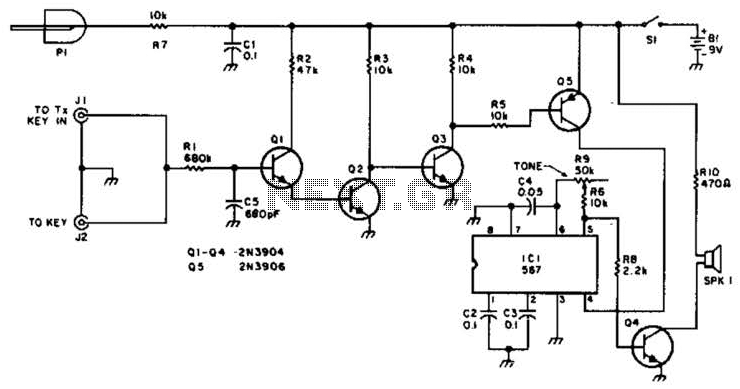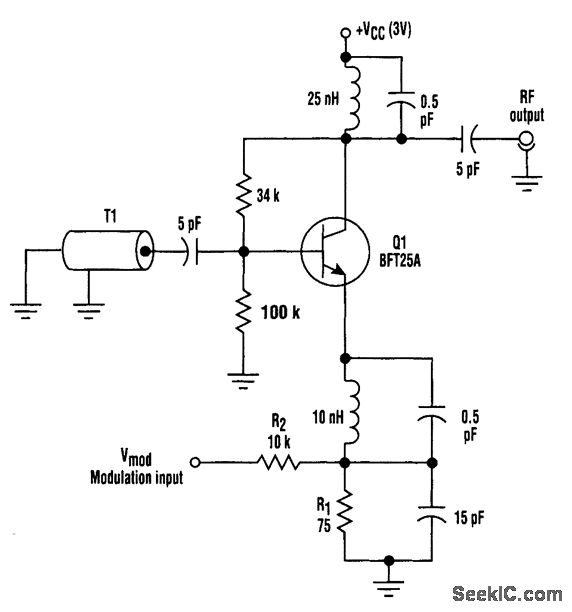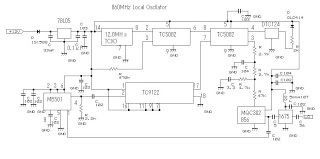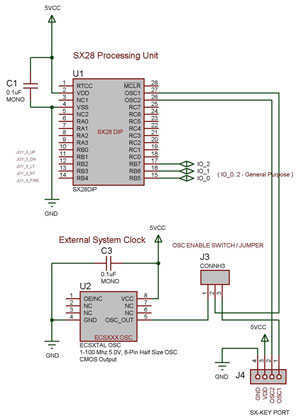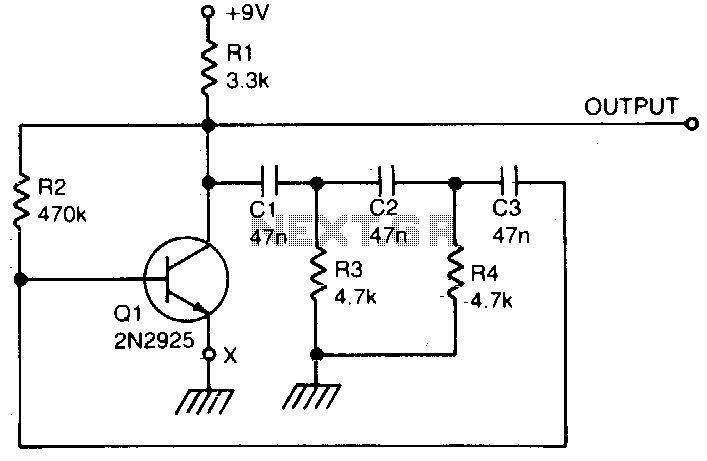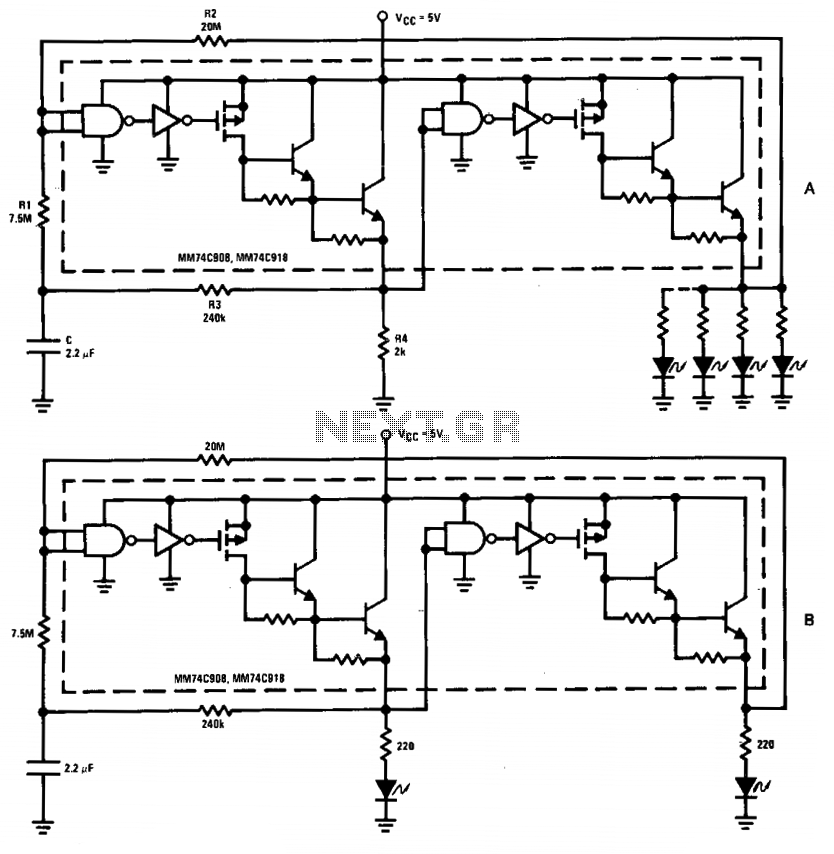
Voltage-Controlled Oscillator
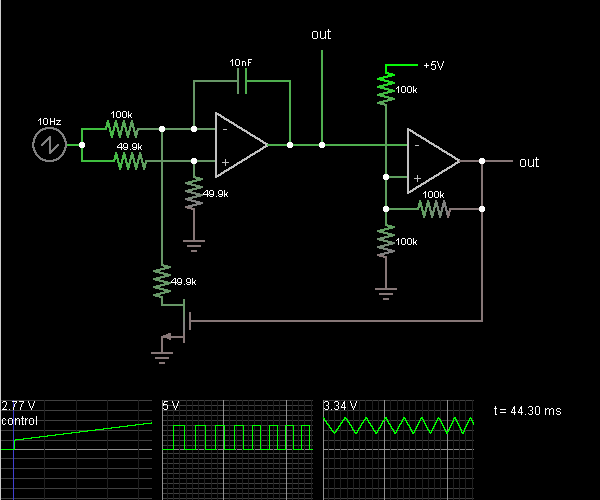
This circuit is a voltage-controlled oscillator, which is an oscillator whose frequency is determined by a control voltage. A 10 Hz sawtooth oscillator provides the control voltage in this case; this causes the frequency to rise slowly until it reaches a maximum and then falls back to the starting frequency. The first operational amplifier (op-amp) functions as an integrator. A voltage divider sets the positive input at half the control voltage. The op-amp strives to maintain its inputs at the same voltage, which necessitates a current flow through a 100kΩ resistor to ensure that the voltage drop across it equals half the control voltage. When the MOSFET at the bottom is activated, the current from the 100kΩ resistor flows through the MOSFET. Since the 49.9kΩ resistor experiences the same voltage drop as the 100kΩ resistor but has half the resistance, it must conduct twice the current. This additional current is sourced from the capacitor, which charges it, requiring the first op-amp to provide a steadily rising output voltage. When the MOSFET is deactivated, the current from the 100kΩ resistor flows through the capacitor, discharging it, thus necessitating a steadily falling output voltage from the first op-amp. The output voltage appears as a triangle wave. The second op-amp operates as a Schmitt trigger, taking the triangle wave as input. When the input voltage exceeds a threshold of 3.33 V, it outputs 5 V, and the threshold voltage drops to 1.67 V. When the input voltage falls below this threshold, the output returns to 0 V, and the threshold increases again. The output is a square wave connected to the MOSFET, which modulates the integrator's output voltage as required.
The voltage-controlled oscillator (VCO) circuit described employs a combination of operational amplifiers and a MOSFET to create a frequency-modulated output based on a control voltage. The initial stage utilizes a 10 Hz sawtooth oscillator to generate the control voltage that dictates the frequency of the VCO. The integrator configuration of the first op-amp is crucial for transforming the control voltage into a linear ramp output, which oscillates between two defined voltage levels.
The voltage divider connected to the positive input of the op-amp ensures that the reference voltage is consistently set to half of the control voltage, allowing the op-amp to maintain a balance between its inputs. The use of a 100kΩ resistor is significant, as it regulates the current flow necessary for the operation of the circuit. When the MOSFET is engaged, it allows the current to flow through, thus influencing the capacitor charging dynamics. The 49.9kΩ resistor plays a pivotal role in determining the rate of change of current, effectively doubling the current flow due to its lower resistance.
The triangle wave output from the first op-amp is essential for the subsequent Schmitt trigger stage, which converts the analog triangle waveform into a digital square wave. The Schmitt trigger's hysteresis characteristics ensure that the output toggles cleanly between high and low states, providing a stable square wave signal that can drive the MOSFET. This square wave output is integral for applications requiring precise frequency control, such as in signal modulation or timing applications. The overall design illustrates a practical implementation of control voltage manipulation to achieve desired frequency outputs, showcasing the versatility of operational amplifiers and MOSFETs in electronic circuit design.This circuit is a voltage-controlled oscillator, which is an oscillator whose frequency is determined by a control voltage. A 10 Hz sawtooth oscillator provides the control voltage in this case; this causes the frequency to rise slowly until it hits a maximum and then falls back to the starting frequency.
The first op-amp is an integrator. A volta ge divider puts the + input at half the control voltage. The op-amp attempts to keep its input at the same voltage, which requires a current flow across the 100k to ensure that its voltage drop is half the control voltage. When the MOSFET at the bottom is on, the current from the 100k goes through the MOSFET. Since the 49. 9k resistor has the same voltage drop as the 100k but half the resistance, it must have twice as much current flowing through it.
The additional current comes from the capacitor, charging it, so the first op-amp must provide a steadily rising output voltage to source this current. When the MOSFET at the bottom is off, the current from the 100k goes through the capacitor, discharging it, so a steadily falling output voltage is needed from the first op-amp.
The third scope shows the output voltage; it looks like a triangle wave. The second op-amp is a Schmitt trigger. It takes the triangle wave as input. When the input voltage rises above the threshold of 3. 33 V, it outputs 5 V and the threshold voltage falls to 1. 67 V. When the input voltage falls below that, the output goes to 0 V and the threshold moves back up. The output is a square wave. It`s connected to the MOSFET, causing the integrator to raise or lower its output voltage as needed. 🔗 External reference
The voltage-controlled oscillator (VCO) circuit described employs a combination of operational amplifiers and a MOSFET to create a frequency-modulated output based on a control voltage. The initial stage utilizes a 10 Hz sawtooth oscillator to generate the control voltage that dictates the frequency of the VCO. The integrator configuration of the first op-amp is crucial for transforming the control voltage into a linear ramp output, which oscillates between two defined voltage levels.
The voltage divider connected to the positive input of the op-amp ensures that the reference voltage is consistently set to half of the control voltage, allowing the op-amp to maintain a balance between its inputs. The use of a 100kΩ resistor is significant, as it regulates the current flow necessary for the operation of the circuit. When the MOSFET is engaged, it allows the current to flow through, thus influencing the capacitor charging dynamics. The 49.9kΩ resistor plays a pivotal role in determining the rate of change of current, effectively doubling the current flow due to its lower resistance.
The triangle wave output from the first op-amp is essential for the subsequent Schmitt trigger stage, which converts the analog triangle waveform into a digital square wave. The Schmitt trigger's hysteresis characteristics ensure that the output toggles cleanly between high and low states, providing a stable square wave signal that can drive the MOSFET. This square wave output is integral for applications requiring precise frequency control, such as in signal modulation or timing applications. The overall design illustrates a practical implementation of control voltage manipulation to achieve desired frequency outputs, showcasing the versatility of operational amplifiers and MOSFETs in electronic circuit design.This circuit is a voltage-controlled oscillator, which is an oscillator whose frequency is determined by a control voltage. A 10 Hz sawtooth oscillator provides the control voltage in this case; this causes the frequency to rise slowly until it hits a maximum and then falls back to the starting frequency.
The first op-amp is an integrator. A volta ge divider puts the + input at half the control voltage. The op-amp attempts to keep its input at the same voltage, which requires a current flow across the 100k to ensure that its voltage drop is half the control voltage. When the MOSFET at the bottom is on, the current from the 100k goes through the MOSFET. Since the 49. 9k resistor has the same voltage drop as the 100k but half the resistance, it must have twice as much current flowing through it.
The additional current comes from the capacitor, charging it, so the first op-amp must provide a steadily rising output voltage to source this current. When the MOSFET at the bottom is off, the current from the 100k goes through the capacitor, discharging it, so a steadily falling output voltage is needed from the first op-amp.
The third scope shows the output voltage; it looks like a triangle wave. The second op-amp is a Schmitt trigger. It takes the triangle wave as input. When the input voltage rises above the threshold of 3. 33 V, it outputs 5 V and the threshold voltage falls to 1. 67 V. When the input voltage falls below that, the output goes to 0 V and the threshold moves back up. The output is a square wave. It`s connected to the MOSFET, causing the integrator to raise or lower its output voltage as needed. 🔗 External reference
